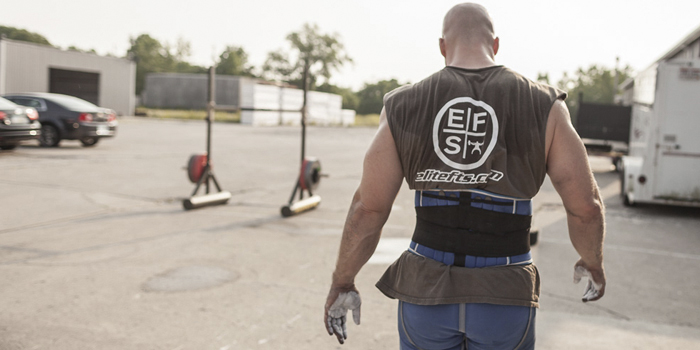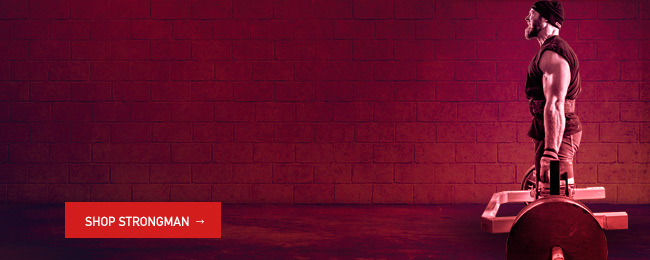
I don't know much about competing in or training for strongman, but I find training the events incredibly valuable for any training goal.
When I think of "functional training," I don't think of curling one-pound dumbbells standing on a Bosu ball with one leg while the other does figure-eights in the air—I think of strongman exercises. What's more functional than farmer's walks (ex. carrying groceries) or picking up an atlas stone (ex. picking up your child or grandchild)? Not only are they functional, but all exercises can be scaled and organized to target any training objective.
Strongman training can be extremely beneficial whether you are a sport athlete trying to build your conditioning, a powerlifter looking to bring up your total, or a weekend warrior trying to get back in shape.
For the Sport Athlete
While training for hockey and soccer, my strength coach incorporated sled pushes, sled rope pulls, and tire flips in my training, primarily for conditioning. Now, as a coach and having greater knowledge about sport preparation, I see even more value in those exercises.
General Physical Preparedness (GPP)
GPP is essential to my athletes' training, especially in the early structural balance phase. Building up my athletes' aerobic capacity and muscular endurance with a higher volume of low impact and minimal muscle damaging exercises will prepare them for the more rigorous or intense training in the following phases.
The exercises also involve different movement patterns that my athletes (primarily hockey players) are not strong in or haven't been exposed to in a long time, thus increasing their athleticism and improving their strength in all positions. For example, hockey includes a ton of rotation from skating and shooting. The fact that hockey players shoot with one side results in a large imbalance in trunk and rotational strength between sides of the body. Therefore, incorporating suitcase carries or any unilateral carry can help balance left and right aspects of the trunk.
Improve Conditioning (While Building Muscle Mass)
As I mentioned, strongman exercises are also great for developing an athlete's anaerobic conditioning by programming them as a circuit. The ratio of work to rest intervals depends on the specific energy system being trained and how far they are from their season.
I find strongman exercises more beneficial than other traditional forms of cardio (ex. bike sprints, dryland sprints, etc.) because they can condition the whole body while also increasing strength and muscle mass from the mechanical load the exercises place on the tissues. My athletes generally return from their seasons with a substantial amount of muscle mass lost, so any means of adding a hypertrophic stimulus without ruining their recovery is beneficial.
| Block 1 | Block 2 | Block 3 | Block 4 |
| A)Tire Flip 9 x 10-15sec B) Prowler® Sprint 9 x 10-15sec C) Zercher Carry 9 x 10-15sec 75sec rest (for each) ~15 ON: 75 OFF 1:5 | A1) Sled Rope Pull 6 x 20m A2) Prowler® Sprint 6 x 40m 2min rest B1) Farmer Walk 6 x 40m B2) Battle Ropes 6 x 15sec 2min rest ~30 ON: 120 OFF 1:4 | A1) Tire Flip 6 x 3 A2) Heavy Prowler 6 x 20m A3) Overhead Med Ball Throw 6 x 5 A4) Prowler® Sprint (Bottom Handle) 6 x 40m 3-4min rest ~45-60 ON: 180 OFF 1:3-4 | Ice Hockey Specific Conditioning (ex. On-ice sprints, small and large games) |
For the Strength Athlete
Strongman competitors are incredibly impressive because of their ridiculous strength, as well as their large muscular frame. If you are a powerlifter looking to add some size along with your total, you should take some pages out of their book to help you add muscle and weight to your lifts.
Here are some ways and reasons why I like to incorporate some strongman training for non-strongman strength athletes:
Improve Main Lifts and Build General Strength
Professionals competing in strongman competitions are generally very strong at everything. Of course, they may have some events they are weaker at, but for the most part, they are just STRONG.
Even though I've been training for over a decade and started with a decent amount of strength, I still consider myself a beginner in powerlifting. Improving my overall strength will help bring up my squat, bench, and deadlift.
For example, I really enjoy doing heavy farmer's walks for my deadlift, and heavy yoke carries for my squat. Both force my body to maintain high levels of tension to stay braced and train the muscles needed for the lifts (upper back for the squat/grip and traps for the deadlift). I'm not saying that my farmer's carries will directly transfer to my deadlift, but I think it's safe to say they will help build a greater foundation of strength for my deadlift to build on.
General Physical Preparedness (or Conditioning)
The reason to include strongman training to increase GPP for a powerlifter is the same as for a sport athlete (build fitness for future intense training). However, the exercise selection and loads will most likely differ depending on the goal of the exercises.
A sport like hockey is generally played in intervals of 30-45 seconds. On the other hand, a competition lift (ex. squat) may last five to seven seconds. This means that the specificity of the conditioning will differ due to the different natures of the sports. Although, if used for strength endurance to rehab an injury or build muscle, the tension placed on the muscles must be longer (normally 30-45 second range, sometimes up to minutes long), and it is, therefore, more appropriate to program longer duration sets or circuits.
How may a powerlifter incorporate strongman work into their current training? I would normally recommend dedicating a whole training session so it doesn't interfere with the other primary sessions. In an ideal scenario, your main training would be Monday, Wednesday, Friday, and then add a fourth day on Saturday where you do your strongman events.
I wrote a previous article about a system that emphasizes a different contraction each day (General Concepts and Progression of the Omni-Contraction System) for athletes, but I've been able to modify it to suit powerlifting. In the article, I talk about a "Gap Day" which is a lower stress day used to address specific weaknesses. This would be the perfect time to add in some general strength work in the form of strongman events for someone lacking raw strength while also building some GPP and muscle tissue.
| Example Training Session | |
| Strength | A) Viking Press – AMRAP in 10min with a weight you could do for 10-12 reps B) Standing Sled Rope Pull – 6 x 20m (weight you can complete the 20m in under 20 seconds) 2 min rest |
| GPP | C1) Sandbag Front Rack Carry – 12 min x 60m C2) Backwards Sled Drag – 12 min x 60m C3) Crossover Sled Drag – 12 min x 60m/side Perform as many circuits as possible in 12 min |
For General Population
The two main goals I see with the general population are to lose weight/fat and to build cardiovascular fitness for general health.
Now, I'm not a lazy person, but I try to be as efficient as possible and choose methods that allow me to address the most objectives with the least amount of work possible to save time to do other things in life.
Sure, you can train with weights three times a week to help with fat loss and then dedicate another two to three sessions a week to your heart, but it would require a lot of time, which is something most individuals don't have or want to give up.
The beauty of strongman training is that it can help achieve both goals simultaneously with minimal to no risk of injury, requires less time, and can "functionally" strengthen the whole body. However, structure and exercise selection are critical factors to consider.
For fat loss, I am a big fan of intervals using strongman exercises, with the intervals dictated by the intensity or energy system looking to be trained. For example, training the alactic system is different than training the aerobic system. Generally, I prefer higher intensity and shorter duration intervals (15-30 second intervals with a 1:2 or 1:3 work-to-rest ratio) because of the metabolic effect post-training. This setup also increases muscle tension and may preserve muscle mass in a fat loss phase.
When choosing exercises, I like to either select those that use the most amount of muscle mass or build a circuit with three to four exercises, each targeting a body part or movement (ex. push, pull, legs, torso). Therefore, you can utilize more muscle mass and benefit from its greater metabolic demand.
If the goal is general health, strongman training can help build the cardiovascular system while also training functionally. Contrary to fat loss, I prefer lower intensity and longer duration interval circuits for heart health (one- to two-minute intervals with 1:0.5 or 1:1 work to rest ratio) and include a small volume of higher intensity (anaerobic) work on a separate day to train both systems.
The concept and structure of the lower intensity circuits are similar to Dr. Fred Hatfield's Peripheral Heart Action Training, in which we try to train nonstop and incorporate the whole body to keep the heart pumping.
Rather than jogging on the treadmill for hours and potentially wearing away my client's hips and knees, I prefer to program more joint-friendly strength work in the form of strongman exercises to train the heart and muscles.
Every circuit includes a 1) weighted carry, 2) lower body, 3) upper body, and 4) explosive exercise. This way, each body part gets a decent amount of rest.
Create a list of each type of exercise and pick and choose which exercise to plug into the circuit.
| Weighted Carry | Lower Body | Upper Body | Explosive |
| Sandbag/Med Ball Carry -Over one shoulder -Front rack position Farmer's Walks Suitcase Carry Trap Bar Carry Bottoms Up KB Walk Piggyback Carry | Sled Drag -Forward -Sideways -Crossover -Reverse -Forward bent over Sled Push -Top Handle -Bottom Handle Med Ball Toss Over Shoulder Tire Flip | Standing Sled Rope Pull Animal Walks (check out Stephane Cazeault–Kilo Strength) Tire Pushes Log Presses Sled Row Med Ball Chest Passes | Med Ball Slams -Rotational -Forward Med Ball Throws -Chest Passes -Rotational -Overhead Battle Ropes Sledgehammer Hits -Sideways -Overhead -Hammer in each hand |
Bonus Benefit: Avoid boredom
To spice things up once in a while or during a deload week, replace a training session with a strongman day. There is something inherently fun about doing some old-school (almost primitive) heavy exercises. Even if you don't do nearly the same weight as professional strongmen and strongwomen competitors, just doing the same exercise makes you feel like you are at their level, which is very satisfying.
Summary
Even though you may not compete or have no ambition of competing in strongman events, I think including some strongman exercises into your current training can have many benefits. Adjust the loads and structure of the sessions depending on what you're trying to achieve. Whether you're looking to bring your deadlift up or want to be in better shape to ski with your wife and kids, strongman training can help you.
Max Daigle is a strength and conditioning coach working with elite-level athletes at Axxeleration Performance Center in Montreal, Canada. After completing his bachelor's degree in physiology, he is pursuing a master's degree in exercise science from McGill University.











1 Comment